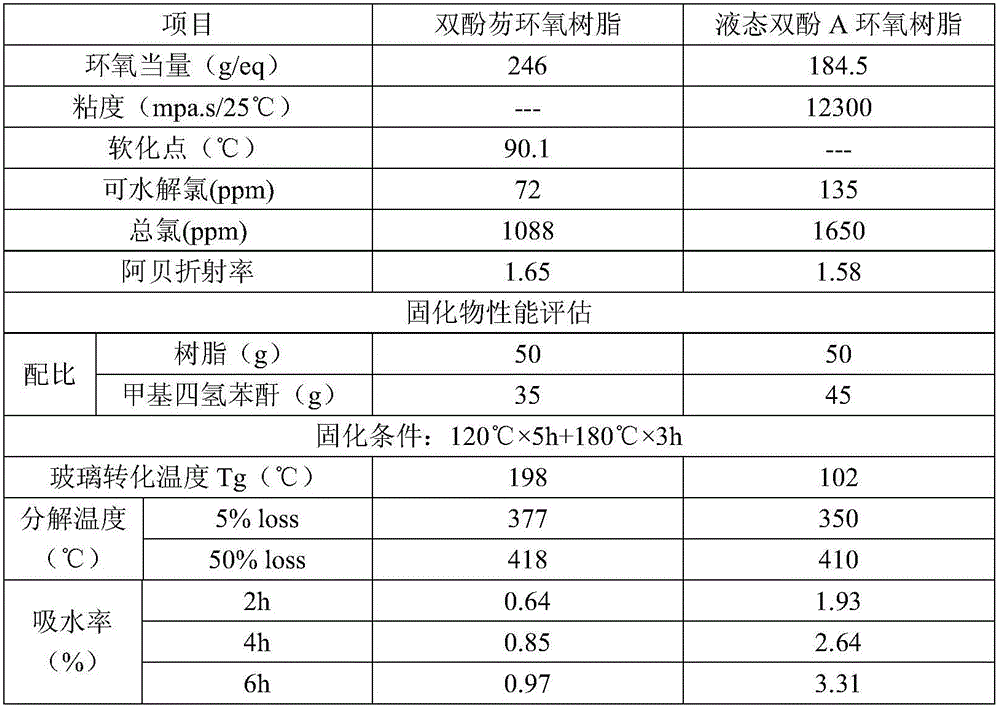Preparation technology of bisphenol fluorene epoxy resin
A bisphenol fluorene epoxy resin and a preparation process technology, applied in the epoxy resin field, can solve the problems of unfavorable electronic device safety performance, limited formulation selection space, reduced insulation performance and the like, and achieve improved chemical stability, good optical properties, The effect of improving the heat and humidity resistance
- Summary
- Abstract
- Description
- Claims
- Application Information
AI Technical Summary
Problems solved by technology
Method used
Image
Examples
preparation example Construction
[0031] The preparation process of the bisphenol fluorene epoxy resin of the present invention comprises: catalytic grafting reaction, ring closure reaction, refining reaction, desalination, concentration, brine treatment process; Obtain high-performance bisphenol fluorene epoxy resin, produce in the production process The sodium chloride waste brine is recovered and concentrated to obtain standard industrial sodium chloride salt, and the water can be reused to achieve clean production.
[0032] The catalytic grafting reaction step includes: grafting bisphenol fluorene and epichlorohydrin in the presence of a catalyst.
[0033] The molar ratio of bisphenol fluorene to epichlorohydrin is 1:5 to 1:20. For 1 mole of bisphenol fluorene, when the number of moles of epichlorohydrin is greater than 15, the recovery of excess epichlorohydrin is large. , time-consuming and energy-consuming, the number of moles is less than 5 pairs of bisphenol fluorene epoxy dissolvability that reaction...
Embodiment 1
[0043] Put 76.6 grams of epichlorohydrin and 28 grams of bisphenol fluorene into a four-port glass reaction tank equipped with a thermometer, a stirring device, a nitrogen injection pipe, and a heating device, stir evenly and rise from normal temperature to 55°C, and add 0.7 grams of 50% sodium hydroxide, and kept stirring at constant temperature for 2 hours. Adjust the vacuum to 210 torr, add 12 g of 50% sodium hydroxide with a quantitative pump, and keep stirring at a constant temperature of 58° C. for 2 hours. Adjust the vacuum to 60torr, and heat to 120°C to recover excess epichlorohydrin. Add 35 g of methyl isobutyl ketone, add 4.6 g of 50% sodium hydroxide, adjust the temperature to 80° C., and keep stirring at constant temperature for 2 hours. Add 30 grams of deionized water and 5 grams of 20% hydrochloric acid solution, stir and let stand for liquid separation, and drain the lower layer of brine. After the resin layer is filtered, the vacuum degree is adjusted to 60 ...
Embodiment 2
[0046] Put 76.6 grams of epichlorohydrin and 28 grams of bisphenol fluorene into a four-port glass reaction tank equipped with a thermometer, a stirring device, a nitrogen injection pipe, and a heating device, stir evenly and rise from normal temperature to 57 ° C, and add 0.7 grams of 50% sodium hydroxide, and kept stirring at constant temperature for 3 hours. Adjust the vacuum degree to 190 torr, add 12 grams of 50% sodium hydroxide with a quantitative pump, and keep stirring at a constant temperature of 62° C. for 2 hours. Adjust the vacuum to 40torr, and heat to 120°C to recover excess epichlorohydrin. Add 35 g of methyl isobutyl ketone, add 13 g of 20% sodium hydroxide, adjust the temperature to 90° C., and keep stirring at constant temperature for 2 hours. Add 30 grams of deionized water and 5 grams of 20% hydrochloric acid solution, stir and let stand for liquid separation, and drain the lower layer of brine. After the resin layer is filtered, the vacuum degree is adj...
PUM
| Property | Measurement | Unit |
|---|---|---|
| Epoxy equivalent | aaaaa | aaaaa |
| Epoxy equivalent | aaaaa | aaaaa |
| Epoxy equivalent | aaaaa | aaaaa |
Abstract
Description
Claims
Application Information
 Login to View More
Login to View More - R&D
- Intellectual Property
- Life Sciences
- Materials
- Tech Scout
- Unparalleled Data Quality
- Higher Quality Content
- 60% Fewer Hallucinations
Browse by: Latest US Patents, China's latest patents, Technical Efficacy Thesaurus, Application Domain, Technology Topic, Popular Technical Reports.
© 2025 PatSnap. All rights reserved.Legal|Privacy policy|Modern Slavery Act Transparency Statement|Sitemap|About US| Contact US: help@patsnap.com

